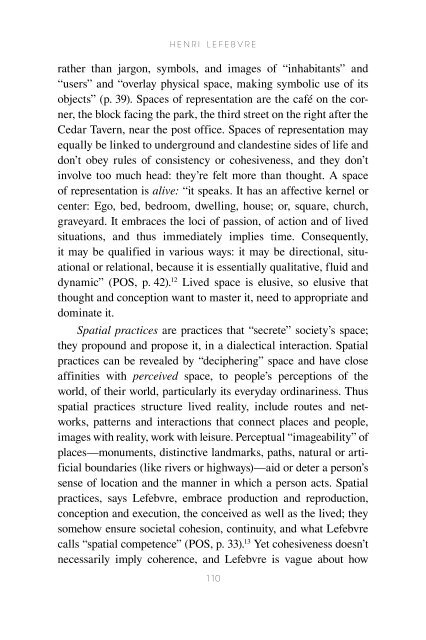Henri Lefebvre: A Critical Introduction - autonomous learning
Henri Lefebvre: A Critical Introduction - autonomous learning
Henri Lefebvre: A Critical Introduction - autonomous learning
Create successful ePaper yourself
Turn your PDF publications into a flip-book with our unique Google optimized e-Paper software.
H e n r i L e F e b v r e<br />
rather than jargon, symbols, and images of “inhabitants” and<br />
“users” and “overlay physical space, making symbolic use of its<br />
objects” (p. 39). Spaces of representation are the café on the corner,<br />
the block facing the park, the third street on the right after the<br />
Cedar Tavern, near the post office. Spaces of representation may<br />
equally be linked to underground and clandestine sides of life and<br />
don’t obey rules of consistency or cohesiveness, and they don’t<br />
involve too much head: they’re felt more than thought. A space<br />
of representation is alive: “it speaks. It has an affective kernel or<br />
center: Ego, bed, bedroom, dwelling, house; or, square, church,<br />
graveyard. It embraces the loci of passion, of action and of lived<br />
situations, and thus immediately implies time. Consequently,<br />
it may be qualified in various ways: it may be directional, situational<br />
or relational, because it is essentially qualitative, fluid and<br />
dynamic” (POS, p. 42). 12 Lived space is elusive, so elusive that<br />
thought and conception want to master it, need to appropriate and<br />
dominate it.<br />
Spatial practices are practices that “secrete” society’s space;<br />
they propound and propose it, in a dialectical interaction. Spatial<br />
practices can be revealed by “deciphering” space and have close<br />
affinities with perceived space, to people’s perceptions of the<br />
world, of their world, particularly its everyday ordinariness. Thus<br />
spatial practices structure lived reality, include routes and networks,<br />
patterns and interactions that connect places and people,<br />
images with reality, work with leisure. Perceptual “imageability” of<br />
places—monuments, distinctive landmarks, paths, natural or artificial<br />
boundaries (like rivers or highways)—aid or deter a person’s<br />
sense of location and the manner in which a person acts. Spatial<br />
practices, says <strong>Lefebvre</strong>, embrace production and reproduction,<br />
conception and execution, the conceived as well as the lived; they<br />
somehow ensure societal cohesion, continuity, and what <strong>Lefebvre</strong><br />
calls “spatial competence” (POS, p. 33). 13 Yet cohesiveness doesn’t<br />
necessarily imply coherence, and <strong>Lefebvre</strong> is vague about how<br />
110
















